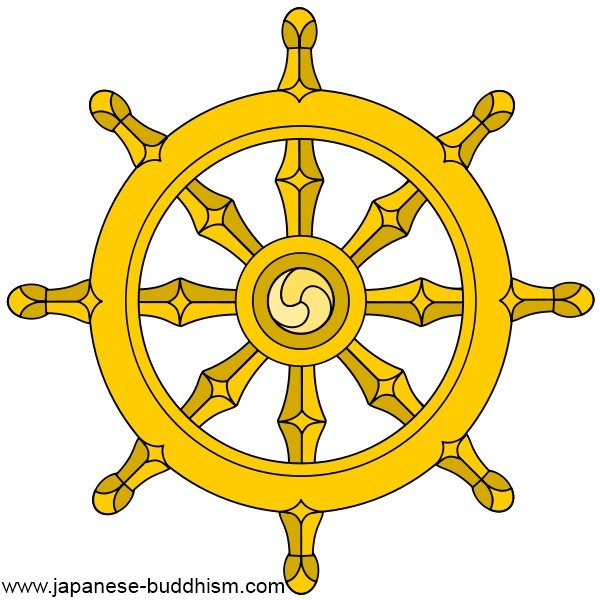The Eight Auspicious
Symbols of Buddhism
The Eight Auspicious Symbols of Buddhism
is a genre of Buddhist symbolism. The symbols derive from Indian
iconography and have become especially popular in Tibetan Buddhism. In
Japan, they are especially used in Shingon and Tendai schools of
Buddhism.
How many people do you know, who just learned about Buddhism?
If you do know a few, then you have certainly noticed that many of them
began their walk to the valley of Buddhism after being curious of
Buddhist symbols.
Many of the Eight Auspicious Symbols were used even before the
awakening of Shakya Muni. Actually with the introduction of Tantric
Buddhism around the 6th century, this genre of artwork and symbolism
became a major part of Buddhism, as imagination and visualization are a
major meditative technique in tantric practices.
A brief description of these eight Auspicious Symbols follows:
Parasol
It refers to an umbrella-like apparatus used for protection from the
sun. Where an umbralla protects from rain, this symbol protects from
defilements. One interpretation is that the dome represents wisdom and
the hanging sides represent compassion. This symbol is usually placed
over Buddha images to protect them from evil influences.

In Japan, the parasol as
depicted in Buddhist art is not very common. The Japanese parasol is
very important in everyday life though as white skin is a norm here.

Golden Fish
The golden fish always come in pairs. One is male and the other
female. They come from Hinduism and used to represent the two major
rivers: the Gange and the Yamuna. Suffering is like a sea because it is
so vast. Only fish can navigate through the sea and choose their own
migration path (representing rebirth) Thus the fish symbolizes the
ability to end suffering and being reborn in the land of Bliss.
In Japan, it is not uncommon to find gargoyle-like fish on top the edges of the roof of castle.

They represent diligence and ecstasy. They also represent the
element of water and the main reason they are put there is to protect
against fire.

Mokugyo
Every family who ows a butsudan has a mokugyo used to mark the rythm
while reciting sutras. This bloc of wood is usually engraved with a
fish. The fish is dragon like as the symbol imported from China, like
many Buddhist things, got transformed with time and distance from its
original Indian roots.
Treasure Vase
The treasure vase symbolizes an eternal rain or a fountain of long
life, abundance and prosperity and all the benefits of this world. It
also represents the space that hold everything in this world.

The vase is present in esoteric Buddhism, especially in the Taizoukai mandara.
Lotus
The lotus signifies the divine nature of the Buddhas. It is believed
that planting a lotus in one’s home enhances the harmonious chi
(energy) that filters through our doorways. When the lotus blooms, it
signifies the advent of a happy occasion.
According to a scholar, “in esoteric Buddhism, the heart of the
beings is like an unopened lotus: when the virtues of the Buddha
develop therein, the lotus blossoms. That is why the Buddha sits on a
lotus bloom.”
This beautiful flower grows in mud and murky waters yet is an object
of beauty, just like compassion can grow out of defilement and
impurities.
Teoh Eng Soon, in his book The Lotus in the Buddhist Art of India,
traces the first appearance of the lotus in Buddhist art to the columns
built by Asoka in the 3rd Century BCE. It is one very well recognized
of the Eight Auspicious Symbols and we often see statues resting on a
bloomed lotus as its base.

Conch Shell
It is used in religious rituals, especially in Shugendo in Japan.
The deep, loud sound of the conch summons the beneficent deities and
dispel evil. Its sound is carries very far when used in mountains, like
the sound of Buddha’s teachings

In Japanese, it is called the horakai and is used by yamabushis.
Endless Knot
The Endless Knot is a geometric diagram which symbolizes the nature
of interrelated reality (reality that only exists as part of a web of
karma and its effect). It also represents the absolute wisdom of the
Buddha and the union of compassion and wisdom, and the illusory
character of time, and long life as it is endless.
Most things in this universe are inter-related and impossible to separate. This knot represent this reality.

Victory Banner
The Victory Banner represents the victory of the teachings of Buddha
over death, ignorance, disharmony and all the negativities of this
world.
It was originally a military standard used in ancient Indian
warfare, and bore the specific badge of each champion. For example in
the Mahabharata, Krishna’s chariot was decorated with a banner showing
the image of the monkey-god Hanuman.
 We can see here Jizo Bosatsy holding a moon disk and a victory banner.
We can see here Jizo Bosatsy holding a moon disk and a victory banner.
Wheel
The term turning of the wheel always means Buddha giving teachings.
When Buddhists request their lamas or gurus to give teachings, they use
the term “turn the wheel of dharma”.

The wheel was a common symbol in early Buddhist art, before the
introduction of Buddha images. It is also the most well known of the
Eight Auspicious Symbols.
In those days, the Dharmachakra symbolized not only the Buddha’s
teachings but the Buddha himself. Four carved lions and four wheels
face the four directions, on the tops of the pillars built by Emperor
Ashoka (272-32 BC), proclaim the Buddhist Dharma throughout India. We
discuss more about the wheel of Dharma here.
|
Return from the Eight Auspicious Symbols to Symbols of Buddhism Return from the Eight Auspicious Symbols to Japanese Buddhism- Home |

New! Comments
Have your say about what you just read! Leave me a comment in the box below.